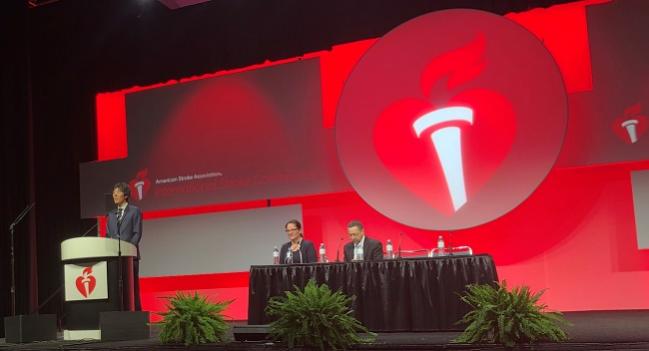SKIP Questions Need for IV Thrombolysis Before Stroke Thrombectomy
Still, given the limitations of the study, clinicians should continue giving IV tPA in eligible patients, Bruce Ovbiagele says.

At 90 days post-procedure in SKIP, the proportion of patients with a modified Rankin Scale (mRS) score of 0 to 2—indicating a favorable outcome—was 59.4% in the group that did not receive IV tPA and 57.3% in the group treated with IV thrombolysis, Kentaro Suzuki, MD, PhD (Nippon Medical School Hospital, Tokyo, Japan), reported last week at the International Stroke Conference here.
In terms of safety, skipping thrombolysis was associated with a lower rate of any intracerebral hemorrhage (ICH) within 36 hours (34% vs 50%; P = 0.02), with no between-group difference in symptomatic ICH.
Commenting for TCTMD, Bruce Ovbiagele, MD (University of California, San Francisco), an American Stroke Association spokesperson, said that even though omitting IV tPA theoretically saves time and reduces the risk of hemorrhagic complications in patients undergoing thrombectomy without sacrificing efficacy, that could not be proven in the SKIP trial.
In a cautionary note, he pointed out that mechanical thrombectomy does not always result in removal of the clot. “That’s a challenge because if you have skipped IV tPA, then . . . you’ve left that patient really no potential opportunity to get treated,” he said, adding that administering thrombolytics after a failed thrombectomy is usually not an option. “It’s almost always too late, but even if it’s not too late, you’ve lost precious time as well.”
In the absence of a definitive trial result showing that it’s okay to skip IV thrombolysis before thrombectomy, clinicians should stick with current recommendations, Ovbiagele said. “Once people present within the appropriate time window, within 4.5 hours, you want to go ahead and give them intravenous tPA and then go ahead and give them [thrombectomy].”
Should tPA Stay or Should It Go?
Both IV tPA and mechanical thrombectomy have proven benefits in patients with acute ischemic stroke, but there is some question about whether thrombolytics are needed before device-based clot removal. Data from the HERMES collaboration, which pools randomized trials of endovascular stroke therapy, have shown that the beneficial effects of thrombectomy did not differ based on whether patients were eligible for or received initial IV thrombolysis. A 2017 meta-analysis of observational data showed that skipping IV tPA was associated with worse functional outcomes and similar safety.
These analyses, however, cannot fully inform the question because most of the patients who did not receive IV tPA in the studies were ineligible for the treatment, Suzuki said.
SKIP was designed to explore whether forgoing IV thrombolysis in eligible patients scheduled for endovascular thrombectomy provided noninferior results to the standard approach. The trial was conducted in 23 sites in Japan and included 204 patients with an acute ischemic stroke, an imaging-confirmed internal carotid artery or MI occlusion, and a time to treatment no greater than 4 hours from stroke onset.
Patients were generally well balanced at baseline, although there were more men in the group that received IV thrombolysis before thrombectomy (70% vs 55%; P = 0.04). Time to treatment was similar in both groups.
The investigators were unable to show that omitting IV tPA was noninferior to the standard approach on any of the functional outcomes. There were no differences between the skipping and standard arms in terms of 90-day death (7.9% vs 8.7%; P = 1.00) or rate of reperfusion after thrombectomy (90% vs 92%; P = 0.78). Those recanalization rates were “quite high,” Suzuki said. In the HERMES data, the pooled rate was 70.5%.
Suzuki acknowledged some limitations of the SKIP trial, including the use of open-label treatment, the fact that it was limited to patients with ICA or M1 occlusions, and the use of a tPA dose of only 0.6 mg/kg.
Todd Neale is the Associate News Editor for TCTMD and a Senior Medical Journalist. He got his start in journalism at …
Read Full BioSources
Suzuki K. The randomized study of endovascular therapy with versus without intravenous tissue plasminogen activator in acute stroke with ICA and M1 occlusion (SKIP study). Presented at: ISC 2020. February 21, 2020. Los Angeles, CA.
Disclosures
- SKIP received funding from the Japanese Society for Neuroendovascular Therapy.
- Suzuki and Ovbiagele report no relevant conflicts of interest.


Comments